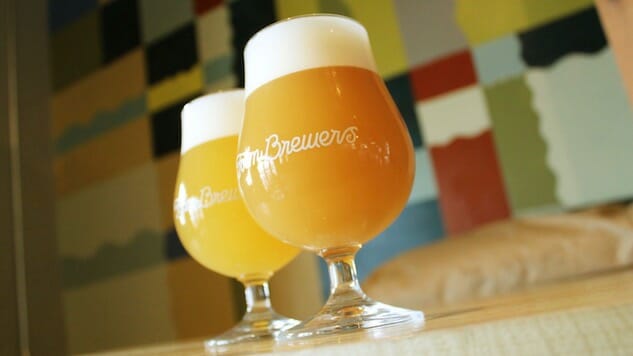The Brewers Association Has Officially Categorized “Juicy or Hazy IPA”
Photos by Jason Stein Drink News India pale ale
In what might well be remembered as an important moment in the history of India pale ale’s evolution, the Colorado-based Brewers Association has done something that many craft beer fans have been requesting for years—they’ve officially recognized the existence of “hazy IPA” as a phenomenon that requires its own style for judging purposes. In the newly released BA style guidelines for 2018, the organization has added three new entries for three styles with the following names: “Juicy or Hazy Pale Ale,” “Juicy or Hazy IPA” and “Juicy or Hazy Double IPA.” The full guidelines can be viewed by clicking right here. As an example, the entry for “Juicy or Hazy IPA” reads as follows:
Juicy or Hazy India Pale Ale
Color: Straw to deep gold
Clarity: Low to very high degree of cloudiness is typical of these beers. Starch, yeast, hop, protein and/or other compounds contribute to a wide range of hazy appearance within this category.
Perceived Malt Aroma & Flavor: Low to low-medium malt aroma and flavor may be present
Perceived Hop Aroma & Flavor: Medium-high to very high hop aroma and flavor are present, with attributes typical of hops from any origin
Perceived Bitterness: Medium-low to medium
Fermentation Characteristics: Low to medium fruity-estery aroma and flavor may be present, but are usually overwhelmed by hop fruitiness. Diacetyl should not be perceived.
Body: Medium-low to medium-high. Perceived silky or full mouthfeel may contribute to overall flavor profile.
Additional notes: Grist may include a small amount of oat, wheat or other adjuncts to promote haziness. Descriptors such as “juicy” are often used to describe the taste and aroma hop-derived attributes present in these beers.
Original Gravity (°Plato) 1.060-1.070(14.7-17.1 °Plato) • Apparent Extract/Final Gravity (°Plato) 1.008-1.016(2.0-4.1 °Plato) • Alcohol by Weight (Volume) 5.0%-6.0%(6.3%-7.5%) • Bitterness (IBU) 50-70; may differ from perceived bitterness • Color SRM (EBC) 4-7(8-14 EBC)
Perhaps the most interesting thing here to my eyes is in the “perceived hop aroma & flavor” section, where it specifies that aromatics and flavors can possess “attributes typical of hops from any origin.” This is a wide-open directive—you can use any kind of hops from any region you want for your NE-IPA, and no one can say that you did it incorrectly if judging from this particular set of style guidelines. That’s pretty big. Also significant is the admission that adjuncts such as oats, wheat or “other adjuncts” are acceptable to promote haziness, leaving brewers with a lot of freedom to experiment as they please there as well.
Most important, though, is the fact that the existence of these new categories will mean “juicy or hazy” pale ale, IPA and DIPA will now have their own categories at the Brewers Association’s Great American Beer Festival in 2018, which will effectively split the monolithic “American IPA” category in half. I reached out to the BA for comment, and they have confirmed that the 2018 GABF competition will feature these styles for the first time.
If you ask us, this is something has has desperately needed to happen for the last few years. It was one of our biggest takeaways while writing about the best beers of the 2017 GABF, because it was impossible to not notice the growing disconnect between the hazy IPAs adored by the crowd in attendance and the staid, classical beers that were winning medals in the category. Although Prairie Madness, the 2017 gold medal-winning IPA from Illinois’ Hailstorm Brewing Co. is a fine beer, it could hardly have highlighted the philosophical disconnect any more perfectly. Malty, amber-colored and featuring plenty of caramel balance to a profile of piney/citrusy hops, it was a nigh-perfect example of IPAs that were popular in this style 10 or even 20 years ago. Meanwhile, the juicy, hazy IPAs that were by far the largest attraction at the festival were being completely ignored in terms of judging because they didn’t fit into any of the preconceived style guidelines. It was clear that something had to happen in terms of the categories if some of the sensational new hazy IPAs were going to have a category in which they could be recognized. Now, they have a home of their very own. Or in other words: A brewery like Tree House or Trillium might actually have a reason to go to GABF this year!
There were also a handful of other updates to the 2018 BA style guidelines, including the creation of a new American pilsner substyle. I’ve bulleted these below:
– Contemporary American-Style Pilsener: The addition of this new category addresses marketplace expansion and provides space for sessionable craft brew lager beers with higher hop aroma than found in pre-prohibition style beers.
– Classic Australian-Style Pale Ale and Australian-Style Pale Ale: This split from one to two Australian-Style Pale Ale categories reflects tremendous diversity in the Australian craft beer market and authoritative input from the technical committee of the Independent Brewers Association. Classic Australian-Style Pale Ale can run slightly darker and typically exhibits relatively lower hop aroma. The Australian-Style Pale Ale category provides ample room for a range of somewhat paler, more hop aroma- and flavor-forward beers being produced today by hundreds of breweries in Australia.
– Gose and Contemporary Gose: Predominantly technical tweaks were made to create more differentiation between these two categories.
Still, it’s obviously NE-IPA that is going to have people buzzing heading into 2018’s GABF. The specter of that festival suddenly just got a lot more exciting. Who is going to take home the first-ever gold medal for hazy IPA? Which beer will be the buzziest IPA of the modern IPA world? I cannot wait to see (and hopefully taste, if it doesn’t disappear immediately).